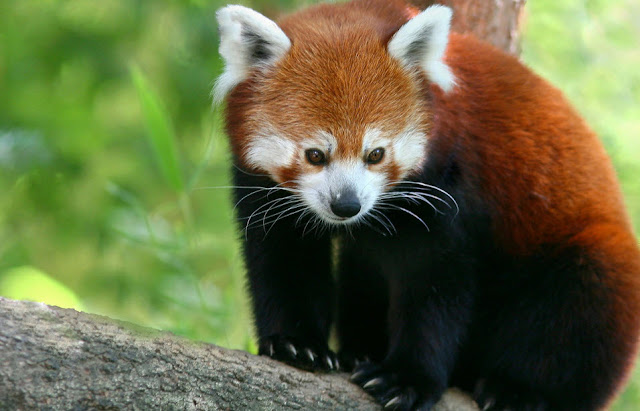The Biggest Animals Kingdom and in The World | Red Panda | The length of the head and body red panda is 50 to 64 cm (20-25 inches), and 28 bit is up to 59 cm (11-23 inches). Males weigh 3.7 to 6.2 kg (8.2 to 14 lb) and females 3 to 6.0 kg (6.6 to 13 lb). They have a long soft fur and red-brown on the upper parts blackish fur on the lower parts, and a tear-stained face clear and robust cranial-dental features. The legs are black and short with thick fur on the soles of the feet. The red panda eats bamboo with strong retractable claws, sharp curves and semi-permanent inward twigs, leaves and fruit removal specialist. Going down a tree in his head, the red panda ankle control to make the descent, one of the few types of climbing. The red panda is endemic to the temperate forests of the Himalayas, and is located between the hills of western Nepal to China in the east. The range includes southern Tibet, Sikkim and Assam in India, Bhutan, the northern mountains of Burma, southwest China. Locations with the highest density of red pandas are a Himalayan region that has been proposed for a refuge for a large number of endemic species in the Pleistocene. The distribution of the red panda disjunction must be considered, rather than continuously. Population lives in the divorced Meghalaya Plateau in northern India.
In a survey conducted in 1970, signs of pandas in Nepal Dhorpatan were hunting. Their presence was confirmed in spring 2007 when four red pandas at an altitude of 3220-3610 m (10,560 feet to 11,840) western limit of the species "is in Rara National Park in the western part of the hunting Dhorpatan have been seen. Prefers deciduous and mixed forests of mountain conifers, especially with old trees and dense bamboo stories. The effective population size of the population of Sichuan is larger and more stable than the population of Yunnan. A southward expansion from Sichuan to Yunnan The red panda became extinct Chinese provinces of Guizhou, Gansu, Shaanxi and Qinghai. The red panda is solitary and territorial. It has been reported that both nocturnal and crepuscular, sleeping on tree branches or in hollow trees during the day and increased its activities in the afternoon and evening. Shortly after waking, red pandas clean their fur like a cat, licking legs and rubbing his back, stomach and hips. Also rub shoulders and hips on the sides of trees or rocks. Red pandas may also use their front paws in the food in the mouth or bring food on the bottom right in the mouth.
Predators red panda, the snow leopard, marten (Mustelidae) and people. The red panda Futa became a tourist attraction in Japan for its ability to withstand for 10 seconds at a time. Red Pandas are excellent climbers and forage largely in trees. They mainly eat bamboo and can small mammals, birds, eggs, flowers and berries to eat. Like pandas, they can not digest cellulose, so it must consume to survive a large number of bamboo. From time to time, to supplement their diet with fish and insects. All you do is sleep, eat, and because of the low calorie diet. Bamboo shoots are easy to digest leaves. Digestibility higher in summer and autumn, intermediate digestibility in spring and winter low digestibility These variations can be correlated with the nutrient content in bamboo. To survive in this poor diet, eat bamboo quality parts such as leaves and tender shoots in large quantities, more than 1.5 kg (3.3 lb) of fresh leaves and 4 kg (8.8 lb ) of fresh sprouts every day. Pandas know artificial sweeteners such as aspartame. Care Moves young puppies often among several nests, each being kept clean. Men rarely contribute to young people, and only if they live in pairs or small groups.
Find The Biggest Animals Kingdom and in The World
<













0 comments
Posting Komentar